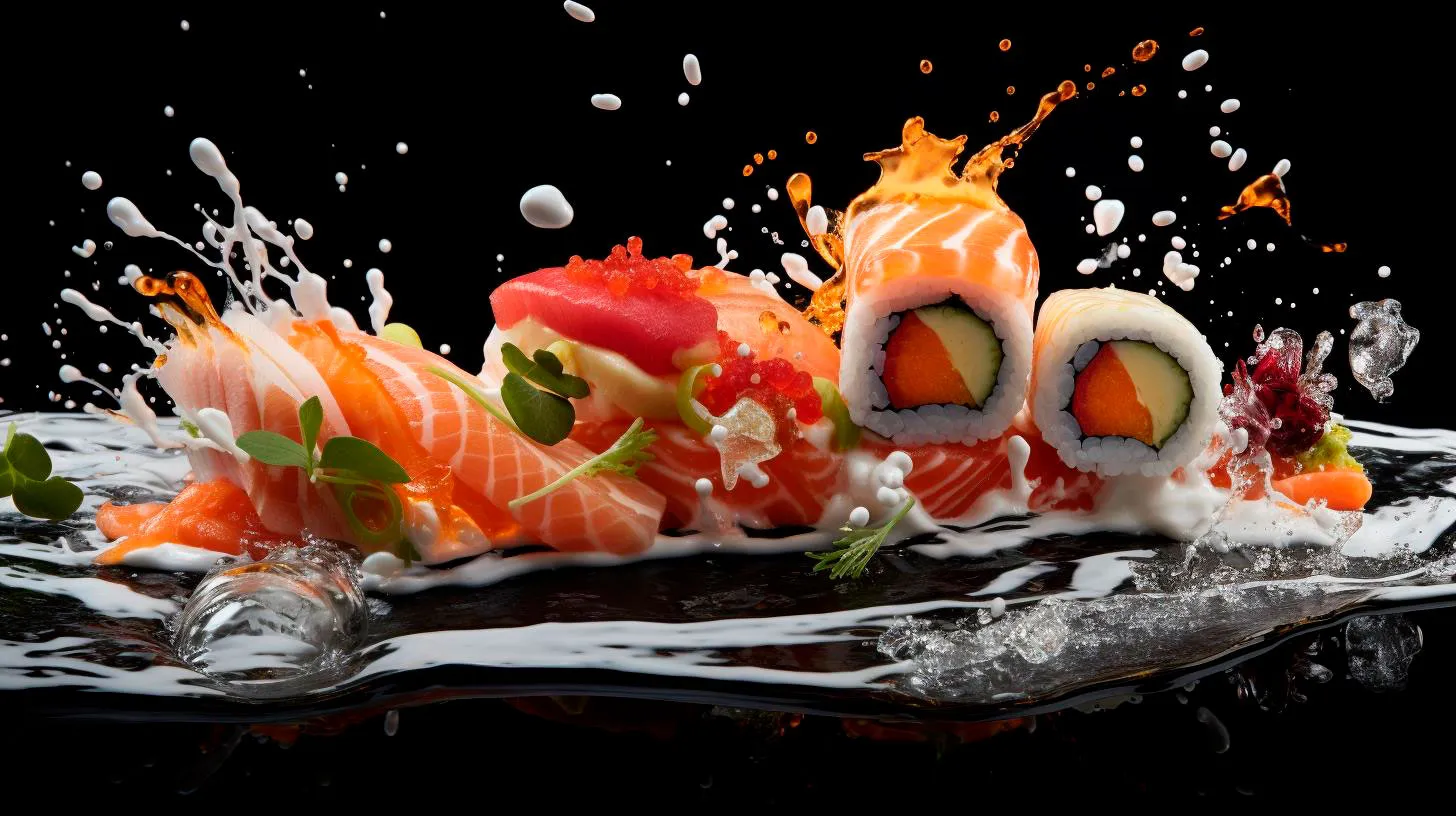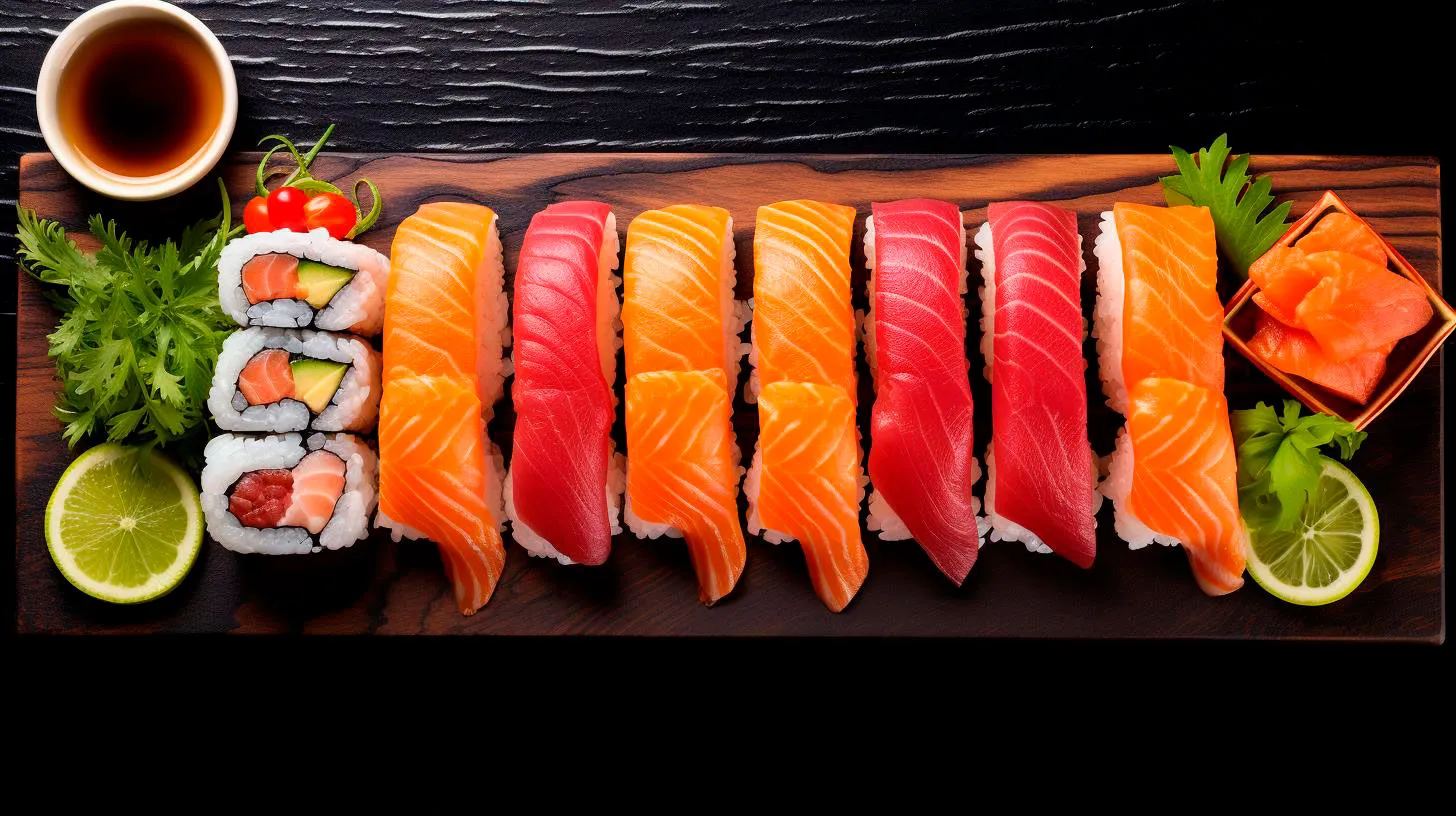Exploring Sushi Varieties that Cater to Different Allergies: A Guide for Allergic Foodies
In this article, we’ll dive into the world of sushi for allergic foodies, exploring the various options and highlighting their key advantages.
Understanding Food Allergies
Food allergies affect millions of people worldwide, and the consequences of consuming allergenic foods can range from mildly uncomfortable to life-threatening. Common food allergens include shellfish, fish, soy, wheat, eggs, dairy, and tree nuts. Allergic reactions can manifest as skin rashes, gastrointestinal distress, respiratory problems, or even anaphylaxis.
When it comes to sushi, allergic foodies need to be particularly cautious as many traditional varieties contain ingredients that are allergenic to some individuals. However, sushi chefs and restaurants have recognized the need to cater to a diverse range of dietary needs, leading to the creation of innovative sushi options that are safe for consumption for individuals with specific allergies.
Sushi Varieties for Allergic Foodies
1. Vegetarian Sushi Varieties
- Veggie rolls: These rolls are typically made with a combination of fresh vegetables, such as cucumber, avocado, and carrots, wrapped in seaweed and rice. They are a flavorful and nutritious option for vegetarians and individuals with seafood allergies.
- Tempura vegetable rolls: This variety combines tempura-battered and deep-fried vegetables, adding a crunchy texture to your sushi experience. Perfect for those with wheat allergies, as the tempura batter can be made gluten-free.
2. Gluten-Free Sushi Varieties
- Sashimi: This option involves thin slices of fish or seafood served without rice. It’s an excellent choice for individuals with gluten intolerance or wheat allergies.
- Nori rolls: Nori is a type of seaweed that is naturally gluten-free. Rolls made solely with nori, rice, and vegetables or fish create a satisfying gluten-free option.
3. Vegan Sushi Varieties
- Asparagus rolls: These rolls feature asparagus as the star ingredient, providing a delicious and healthy option for vegans and individuals with dairy and seafood allergies.
- Bean curd rolls: Made from tofu skin, these rolls offer a burst of flavor and a protein-packed alternative for vegans and those with lactose intolerance.
4. Low-Sodium Sushi Varieties
- Sashimi with Ponzu sauce: Ponzu sauce is a citrus-based dressing that is typically low in sodium. Pairing sashimi with Ponzu sauce allows individuals with high blood pressure or sodium-restricted diets to enjoy sushi without sacrificing taste.
- Edamame rolls: Edamame, or young soybeans, are a nutritious and low-sodium option for sushi enthusiasts looking to reduce their sodium intake.
The Advantages of Allergy-Friendly Sushi
Choosing allergy-friendly sushi not only allows individuals with food allergies to enjoy this popular cuisine, but it also offers several advantages:
- Healthier options: Allergy-friendly sushi varieties often include more vegetables, providing essential nutrients and fiber.
- Safe dining experience: By opting for sushi catered to specific allergies, allergic foodies can have peace of mind knowing that their meal is safe to consume.
- Increased variety: Allergy-friendly sushi expands the range of options available, ensuring that there is something for everyone to enjoy.
- Accommodating dietary needs: Sushi restaurants that offer allergy-friendly options demonstrate a commitment to accommodating diverse dietary needs and preferences.
It’s important to remember that while allergy-friendly sushi options are available, cross-contamination can still occur in some kitchens. When dining out with a food allergy, communicating your concerns to the sushi chef and staff is crucial to ensure a safe dining experience.
With the rising awareness surrounding food allergies, it’s heartening to see sushi restaurants embracing inclusivity and catering to the needs of allergic foodies. By exploring the various allergy-friendly sushi varieties, individuals with food allergies can savor the flavors of this beloved cuisine without compromising their health.
Navigating Allergies: A Guide to a Safe and Enjoyable Sushi Experience
So, let’s dive in!
Understanding Common Allergies
Before talking specifically about sushi-related allergies, it’s important to have a basic understanding of common allergens. Some of the most well-known allergies include:
- Shellfish Allergy: One of the most prevalent allergies, shellfish allergy affects millions of people worldwide. It is essential to determine whether you have an allergy to crustaceans like shrimp, crab, or lobster before diving into sushi.
- Seafood Allergy: While often confused with shellfish allergy, seafood allergy encompasses a wider range of fish and shellfish. Common culprits include salmon, tuna, mackerel, and more.
- Soy Sauce Allergy: Soy sauce, a staple in sushi cuisine, contains soybeans. Some individuals are allergic to soy products, so it’s crucial to be aware if this applies to you.
- Gluten Allergy: Although traditionally made with rice, some sushi rolls may contain ingredients with gluten, such as imitation crab meat or sauces. Gluten intolerance or celiac disease sufferers should be cautious in their sushi choices.
Tips for a Safe Sushi Experience
When it comes to enjoying sushi with allergies, a little planning and awareness can go a long way. Consider the following tips to navigate your sushi experience safely:
1. Communicate with the Staff:
Inform your servers or sushi chefs about your specific allergies. They can guide you through the menu, suggesting safe options and ensuring your sushi is prepared in a separate area to avoid cross-contamination. Communication is key to a successful and safe dining experience.
2. Read the Menu Carefully:
Thoroughly read the menu to identify potential allergens. Look for dish descriptions that include ingredients you are allergic to and avoid them. Most menus nowadays also offer gluten-free or allergen-friendly indications to assist diners.
3. Opt for Sashimi:
If you are allergic to shellfish or seafood, sushi options like sashimi can be a fantastic alternative. Sashimi typically consists of thinly sliced raw fish without rice or any other potential allergens, making it a safe and protein-packed choice.
4. Stick to Simple Rolls:
Sushi rolls that don’t contain cooked or mixed ingredients are generally safer for individuals with allergies. Simple rolls like cucumber or avocado rolls are minimalistic yet delicious options to consider.
5. Bring Your Own Sauce:
If you cannot consume soy sauce due to a soy allergy, bring your own alternative sauce. Many brands offer gluten-free and soy-free soy sauce alternatives that you can carry discreetly in small containers.
The Benefits of Enjoying Allergen-Friendly Sushi
Now that you understand how to navigate sushi with allergies, let’s explore some of the significant benefits:
- Expanded Culinary Horizons: Embracing allergen-friendly sushi alternatives introduces you to new flavors and textures, allowing you to explore a wider range of culinary experiences.
- Improved Safety: By taking the necessary precautions and communicating with the staff, you can enjoy your sushi without worrying about allergic reactions or compromising your health.
- Enhanced Dining Experience: When you actively participate in customizing your sushi rolls based on your allergies, you become an integral part of the dining process. This involvement ensures your preferences are met, leading to a more enjoyable experience overall.
Remember, being proactive and prepared will ensure that your sushi experience remains safe and enjoyable, even with allergies. So, go ahead and embark on a tasteful journey, exploring the wonders of allergen-friendly sushi!
Allergy-Friendly Sushi: Uncovering Delicious Options for Various Dietary Restrictions
In this article, we will explore some delicious alternatives for sushi lovers with common allergies, offering a new twist on this beloved dish without compromising on taste or quality.
1. Gluten-Free Sushi
Gluten sensitivity and celiac disease affect millions of people around the globe. The good news is that the sushi world has recognized this, and gluten-free alternatives are now widely available. Here are some gluten-free options to look for:
- Seaweed wraps: Opt for sushi rolls wrapped in seaweed (nori) instead of traditional soy wrappers. Seaweed is naturally gluten-free and adds a unique flavor.
- Choose your fillings wisely: Stick to fillings like fresh vegetables, avocado, cucumber, and sashimi-grade fish. These options are typically gluten-free and provide a burst of flavor in every bite.
- Ask for gluten-free soy sauce: Many restaurants now offer gluten-free soy sauce or tamari as an alternative. It’s always a good idea to confirm with your server or chef.
Remember, it’s important to communicate your dietary needs with the sushi chef or staff to ensure that cross-contamination doesn’t occur during the preparation process.
2. Dairy-Free Sushi
Dairy allergies or lactose intolerance shouldn’t keep you from enjoying sushi. Fortunately, there are dairy-free options available that are just as delicious. Consider these alternatives:
- Use alternative sauces: If you’re avoiding dairy, you can still enjoy flavorful sushi by asking for alternative sauces like ponzu or gluten-free teriyaki sauce.
- Experiment with fillings: Swap cream cheese and mayo-based fillings with dairy-free alternatives like hummus, avocado, or vegan cream cheese.
- Explore vegan sushi options: Some sushi restaurants offer vegan sushi rolls made with creative ingredients like tofu, asparagus, and pickled vegetables.
Remember, always inform the sushi chef about your dairy allergy so they can accommodate your needs and offer suitable alternatives.
3. Nut-Free Sushi
Nut allergies, including peanuts and tree nuts, can be potentially life-threatening and should be taken seriously. When dining out for sushi, consider the following nut-free options:
- Avoid toppings and fillings with nuts: Opt for sushi rolls without nuts, such as those filled with cucumber, fish, or avocado.
- Choose a reputable restaurant: Select a sushi restaurant that is knowledgeable about allergens and cross-contamination.
- Consider the preparation area: Ensure that the sushi is prepared in an area that is free from nut contamination to avoid any accidental exposure.
As always, it’s crucial to communicate your nut allergy to the sushi chef and ask about any potential cross-contamination risks.
Key Takeaways
When it comes to sushi, individuals with dietary restrictions can still indulge in this culinary delight. By exploring allergy-friendly options and communicating your needs with the sushi chef, you can enjoy a safe and delicious meal. Here are some key takeaways to remember:
- Gluten-free sushi options include seaweed wraps and carefully chosen fillings.
- Dairy-free alternatives include swapping sauces and fillings, as well as exploring vegan sushi options.
- For those with nut allergies, it’s important to avoid nut-based ingredients and choose a reputable restaurant.
- Always communicate your dietary needs to the sushi chef to ensure a safe dining experience.
Remember, sushi can bring joy to individuals with different dietary restrictions, offering a delectable meal that is both allergy-friendly and full of flavor. Embrace the options available to you and savor every bite!
Deliciously Safe Discovering Allergy-Friendly Sushi for Every Taste Preference
Allergy-Friendly Sushi: A Surprising Delight
For those with dietary restrictions or allergies, navigating the sushi menu can sometimes feel overwhelming. The good news is that modern sushi chefs have been creative in inventing an array of allergy-friendly options to ensure that everyone can experience the joy of sushi. Here’s what makes allergy-friendly sushi a surprising delight:
- Diverse Ingredients: Allergy-friendly sushi offers a wide variety of ingredients beyond raw fish. From cooked seafood such as crab or shrimp to vegetarian options like avocado, cucumber, and tofu, there is an abundance of flavors to explore.
- Gluten-Free Options: Many sushi restaurants now offer gluten-free soy sauce or tamari as an alternative to the traditional soy sauce, allowing those with gluten sensitivities or celiac disease to enjoy their sushi guilt-free.
- Creative Substitutions: Sushi chefs have become experts at finding creative substitutes for common allergens. For example, they may use gluten-free breadcrumbs or tempura batter to accommodate those with wheat allergies.
Key Takeaways for Allergy-Friendly Sushi
When it comes to allergy-friendly sushi, there are several key takeaways to keep in mind:
- Variety: Allergy-friendly sushi offers a wide range of ingredients and flavors catering to different dietary needs and preferences.
- Accommodations: Many sushi restaurants are committed to accommodating customers with allergies, offering customizable options and ingredient substitutions.
- Global Demand: The demand for allergy-friendly sushi is growing globally. Restaurants are recognizing the importance of catering to diverse dietary needs to satisfy a broader customer base.
Advantages of Seeking Allergy-Friendly Sushi
Choosing allergy-friendly sushi brings several advantages to the table:
- Diversity: Allergy-friendly sushi allows individuals with dietary restrictions to experience the rich flavors and textures of this beloved cuisine.
- Health Benefits: Allergy-friendly sushi often includes more plant-based options, providing an excellent opportunity to incorporate more vegetables and nutrients into one’s diet.
- Inclusivity: By offering allergy-friendly options, sushi restaurants promote inclusivity and ensure that all customers can dine together without concerns about dietary limitations.
Industry Statistics on Allergy-Friendly Sushi
Here are some interesting industry statistics related to allergy-friendly sushi:
- According to a global survey, over 50% of people have dietary restrictions or preferences when dining out, highlighting the importance of allergy-friendly options.
- Approximately 32 million Americans have food allergies, creating a significant demand for allergy-friendly dining experiences.
- Over the past five years, the gluten-free market has grown at a CAGR of 9.1%, indicating the rising popularity of gluten-free alternatives in various cuisines, including sushi.
Now that you’re equipped with knowledge about allergy-friendly sushi, dive into this delightful cuisine without any concerns. With its diverse ingredients, creative substitutions, and dedication to inclusivity, allergy-friendly sushi is here to make your dining experience safe and mouthwateringly satisfying. So, grab your chopsticks and embark on a sushi adventure!


